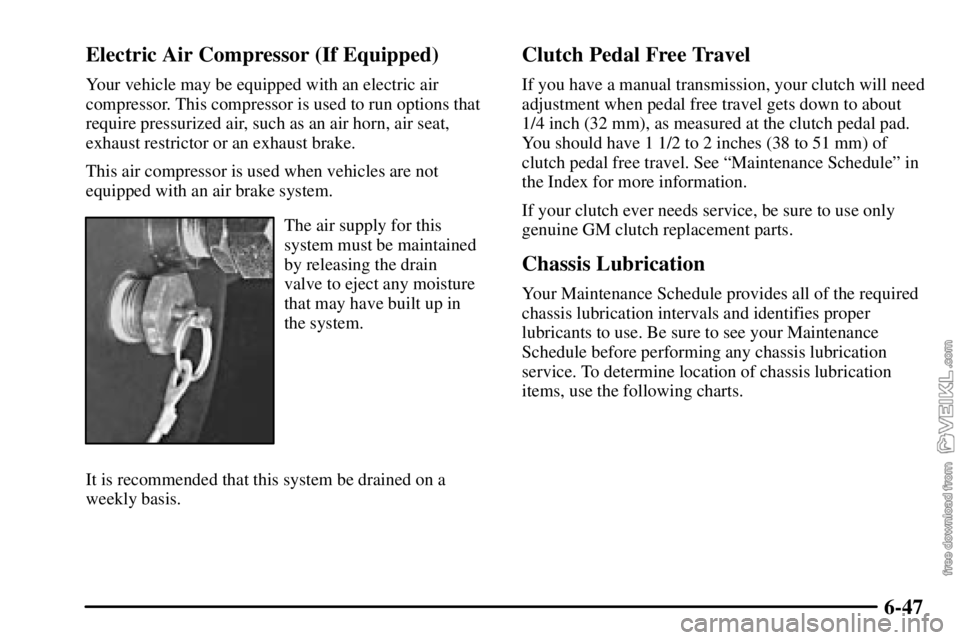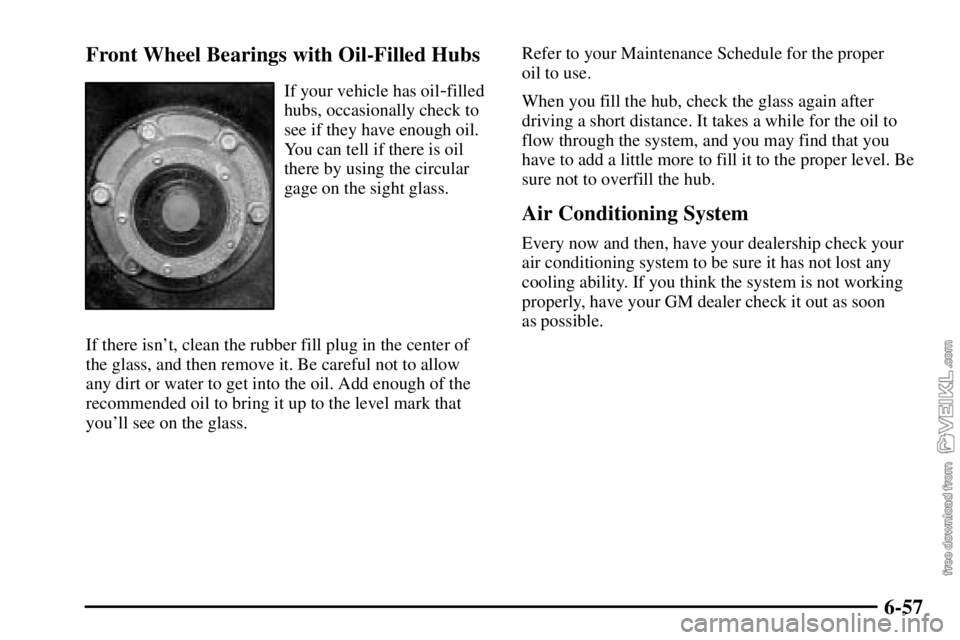Page 300 of 386

6-46 Air Brake Systems (If Equipped)
If you have air brakes, it is important to get rid of
moisture in the system. Moisture will damage your
system if it isn't removed daily.
There are two ways to do this. One is automatic if your
air
-brake vehicle has the optional moisture ejector.
If your vehicle doesn't have that option, however, you
must drain the air reservoirs occasionally to be sure the
air dryer is working properly.
Drain the air brakes at full system pressure. To be sure
you're at full pressure, check your air pressure gage.
It should read at least 100 psi (692 kPa).
Moisture Ejector (Option)
If you have air brakes with a moisture ejector, the valve
automatically ejects moisture from the reserve tank
when the air compressor cycles.
Air Dryer
If your vehicle has air brakes, you have an air dryer.
This collects and removes dirt, moisture or other foreign
matter from the air prior to entering the brake system.
It is mounted on the passenger's side frame rail.
If your dryer is a Bendix
-Westinghouse, it has a
filter that you need to change at intervals. See your
Maintenance Schedule for more about servicing
this filter.
Page 301 of 386

6-47 Electric Air Compressor (If Equipped)
Your vehicle may be equipped with an electric air
compressor. This compressor is used to run options that
require pressurized air, such as an air horn, air seat,
exhaust restrictor or an exhaust brake.
This air compressor is used when vehicles are not
equipped with an air brake system.
The air supply for this
system must be maintained
by releasing the drain
valve to eject any moisture
that may have built up in
the system.
It is recommended that this system be drained on a
weekly basis.
Clutch Pedal Free Travel
If you have a manual transmission, your clutch will need
adjustment when pedal free travel gets down to about
1/4 inch (32 mm), as measured at the clutch pedal pad.
You should have 1 1/2 to 2 inches (38 to 51 mm) of
clutch pedal free travel. See ªMaintenance Scheduleº in
the Index for more information.
If your clutch ever needs service, be sure to use only
genuine GM clutch replacement parts.
Chassis Lubrication
Your Maintenance Schedule provides all of the required
chassis lubrication intervals and identifies proper
lubricants to use. Be sure to see your Maintenance
Schedule before performing any chassis lubrication
service. To determine location of chassis lubrication
items, use the following charts.
Page 308 of 386
6-54
Other Service Items
Fuel Filter (Gasoline Engines)
The steel fuel filter is located near the engine
compartment on the driver's side of the vehicle.
See your Maintenance Schedule for recommended
service intervals.If your vehicle is equipped with the optional Davco
spin
-on type filter, it is located on the driver's side
frame rail.
Fuel Filter (Diesel Engines)
If you have a diesel engine, your fuel filter is located in
the engine compartment on the driver's side of the
vehicle, or along the driver's side frame rail. See ªFuel
Filter Replacementº earlier in this section for further
information.
Also see your Maintenance Schedule for recommended
service intervals.
Page 311 of 386

6-57 Front Wheel Bearings with Oil-Filled Hubs
If your vehicle has oil-filled
hubs, occasionally check to
see if they have enough oil.
You can tell if there is oil
there by using the circular
gage on the sight glass.
If there isn't, clean the rubber fill plug in the center of
the glass, and then remove it. Be careful not to allow
any dirt or water to get into the oil. Add enough of the
recommended oil to bring it up to the level mark that
you'll see on the glass.Refer to your Maintenance Schedule for the proper
oil to use.
When you fill the hub, check the glass again after
driving a short distance. It takes a while for the oil to
flow through the system, and you may find that you
have to add a little more to fill it to the proper level. Be
sure not to overfill the hub.
Air Conditioning System
Every now and then, have your dealership check your
air conditioning system to be sure it has not lost any
cooling ability. If you think the system is not working
properly, have your GM dealer check it out as soon
as possible.
Page 319 of 386
6-65
CAUTION:
Rust or dirt on a wheel, or on the parts to which
it is fastened, can make the wheel nuts become
loose after a time. The wheel could come off and
cause a crash. When you change a wheel, remove
any rust or dirt from the places where the wheel
attaches to the vehicle. In an emergency, you can
use a cloth or paper towel to do this; but be sure
to use a scraper or wire brush later, if you need
to, to get all the rust or dirt off.
How Often to Check
Wheel tightness is so important you should have a
technician check nut tightness on all wheels with a
torque wrench after your first 100 miles (160 km), and
then 1,000 miles (1 600 km) after that. Be sure to repeat
this service whenever you have a tire removed or
serviced. See ªMaintenance Scheduleº in the Index for
further information.
Page 347 of 386
7-
7-1
Section 7 Maintenance Schedule
This section covers the maintenance required for your vehicle. Your vehicle needs these services to retain its safety,
dependability and emission control performance.
7
-2 Introduction
7
-4 Part A: Scheduled Maintenance Services
7
-5 Scheduled Maintenance7
-21 Part B: Owner Checks and Services
7
-27 Part C: Recommended Fluids and Lubricants
7
-30 Part D: Maintenance Record
Page 349 of 386

7-3 How This Section is Organized
This maintenance schedule is divided into four parts:
ªPart A: Scheduled Maintenance Servicesº explains
what to have done and how often. Some of these
services can be complex, so unless you are technically
qualified and have the necessary equipment, you should
let your dealer's service department or another qualified
service center do these jobs.
CAUTION:
Performing maintenance work on a vehicle can
be dangerous. In trying to do some jobs, you can
be seriously injured. Do your own maintenance
work only if you have the required know
-how
and the proper tools and equipment for the job.
If you have any doubt, have a qualified
technician do the work.
If you want to get the service information, see ªService
and Owner Publicationsº in the Index.ªPart B: Owner Checks and Servicesº tells you
what should be checked and when. It also explains what
you can easily do to help keep your vehicle in good
condition.
ªPart C: Recommended Fluids and Lubricantsº lists
some recommended products necessary to help keep
your vehicle properly maintained. These products, or
their equivalents, should be used whether you do the
work yourself or have it done.
ªPart D: Maintenance Recordº is a place for
you to record and keep track of the maintenance
performed on your vehicle. Keep your maintenance
receipts. They may be needed to qualify your vehicle
for warranty repairs.
Page 350 of 386

7-4
Part A: Scheduled Maintenance
Services
Using Your Maintenance Schedule
We at General Motors want to help you keep your
vehicle in good working condition. But we don't know
exactly how you'll drive it. You may drive very short
distances only a few times a week. Or you may drive
long distances all the time in very hot, dusty weather.
You may use your vehicle in making deliveries or in
many other ways.
Because of all the different ways people use their
vehicles, maintenance needs vary. You may need more
frequent checks and replacements. So please read the
following and note how you drive. If you have any
questions on how to keep your vehicle in good
condition, see your dealer.
This part tells you the maintenance services you should
have done and when you should schedule them. If you
go to your dealer for your service needs, you'll know
that GM
-trained and supported service people will
perform the work using genuine GM parts.The proper fluids and lubricants to use are listed in
Part C. Make sure whoever services your vehicle uses
these. All parts should be replaced and all necessary
repairs done before you or anyone else drives
the vehicle.
This schedule is for vehicles that:
�carry passengers and cargo within recommended
limits. You will find these limits on your vehicle's
GVW Rating label. See ªLoading Your Vehicleº in
the Index.
�are driven on reasonable road surfaces within legal
driving limits.
�use the recommended fuel. See ªFuelº in the Index.
Scheduled Maintenance Supplements
If your vehicle has a Caterpillar� diesel engine, your
owner's manual is supplemented by the Caterpillar�
Diesel Engine Operation & Maintenance Manual. If
your vehicle has an Allison transmission, your owner's
manual is supplemented by an Allison Transmission
Operator's Manual. Always refer to these manuals for
related maintenance services.